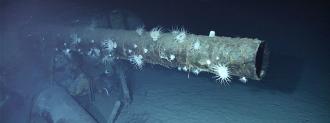In 1948, the USS Nevada — a battleship once deemed “unsinkable” — plunged beneath the surface of the Pacific Ocean, deliberately scuttled by one of the U.S. military’s own torpedoes.
Some 70 years later, maritime archaeology firm SEARCH Inc. teamed up with seabed exploration company Ocean Infinity to hunt down the legendary ship’s wreckage.
On May 11, they announced that they’d found the historic ship — and had stunning images of the wreckage to share with the world.
Tracking Down the USS Nevada
Working only off of eyewitness accounts of the USS Nevada’s sinking, Ocean Infinity narrowed the ship’s final resting place down to an area covering 100 square miles.
Using an untethered autonomous underwater vehicle (AUV), the crew of the company’s Pacific Constructor managed to locate the wreckage 65 nautical miles southwest of Pearl Harbor.
The battleship was more than 15,400 feet below the water’s surface — almost three miles deep — but the depth wasn’t a problem for Ocean Infinity: its AUV is capable of operating at a depth of nearly 20,000 feet.
After they located the USS Nevada, Ocean Infinity’s researchers sent a remotely operated vehicle down to take photos of the wreckage, transmitting the pictures in real time to SEARCH’s office in Florida for analysis.
“We are proud to have participated in this historic mission, which provides a tangible example of how technology can magnify the potential for discovery,” James Pochurek, SEARCH’s president, said in a statement.
A Historic Battleship
The U.S. Navy launched the USS Nevada in 1914, and over the course of the next 34 years, the ship became one of the most legendary vessels in U.S. military history.
It was deployed during World War I, and after the war ended, it served as part of the fleet that escorted president Woodrow Wilson to the Paris Peace Conference.
During the Japanese military’s attack on Pearl Harbor, the USS Nevada was one of eight battleships bombed, and after being repaired, it later participated in the Normandy Invasion (D-Day).
After its decommissioning in 1946, the USS Nevada was used as a target for the U.S.’s Bikini Atoll atomic testing experiments, during which it survived two nearby atomic bomb attacks.
In 1948, the ship became a target for gunnery practice, and when four days of that wasn’t enough to sink it, the U.S. military resorted to using an aerial torpedo.
That’s the story, anyways — based on SEARCH’s initial analysis of the wreckage images, Senior Vice President James Delgado told National Geographic he thinks it might have taken two torpedoes, not one, to sink the unsinkable battleship.
We’d love to hear from you! If you have a comment about this article or if you have a tip for a future Freethink story, please email us at [email protected].





